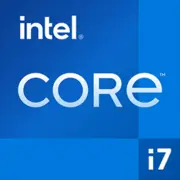Intel Core i7-13700T

인텔 코어 i7-13700T: 2025년 프로세서에 대한 종합 리뷰
2025년 3월
소개
인텔 코어 i7-13700T 프로세서는 Raptor Lake 라인업에서 발표되었으며, 높은 성능과 에너지 효율성을 결합한 하이브리드 아키텍처의 전통을 이어갑니다. 이 칩은 최고 모델에 대한 추가 비용 없이 작업을 위한 성능이 필요한 사용자들을 대상으로 설계되었습니다. 본 기사에서는 이 프로세서의 특징, 호환성, 사용 시나리오를 살펴보고 경쟁 제품과 비교해 보겠습니다.
1. 주요 사양
아키텍처 및 제조 공정
i7-13700T는 8개의 고성능 코어(P-Core)와 8개의 전력 효율적인 코어(E-Core)를 결합한 Raptor Lake 하이브리드 아키텍처(인텔 7)에 기반하고 있습니다. 이를 통해 작업을 분산시킬 수 있으며, P-Core는 무거운 계산을 담당하고 E-Core는 백그라운드 프로세스를 처리합니다. 인텔 7 공정(10nm Enhanced SuperFin)은 성능과 열 발산 간의 균형을 제공합니다.
성능
- 16코어 / 24스레드: 멀티스레드 작업(렌더링, 인코딩)에서 칩은 Geekbench 6 멀티코어에서 11552점을 기록합니다.
- 싱글 스레드 성능: Geekbench 6 싱글코어에서 2406점으로 게임 및 IPC에 의존하는 애플리케이션을 원활하게 실행할 수 있습니다.
- L3 캐시: 30MB의 캐시는 데이터 처리 속도를 향상시키고 지연을 줄입니다.
주요 특징
- PCIe 5.0 지원: 최신 SSD 및 그래픽 카드에 적합합니다.
- 인텔 스레드 디렉터: 코어 간 작업 분산을 최적화합니다.
- 인텔 UHD 그래픽스 770: 기본 작업 및 AV1 디코딩을 위한 내장 그래픽입니다.
2. 호환 가능한 마더보드
소켓 및 칩셋
이 프로세서는 LGA 1700 소켓을 사용하며 호환되는 칩셋은 다음과 같습니다:
- Z790: 오버클러킹 및 PCIe 5.0 x16을 지원하는 얼티밋 선택. 예: ASUS ROG Strix Z790-E Gaming ($350).
- B760: 대부분의 사용자에게 최적의 선택(DDR5, PCIe 4.0 지원). 예: MSI MAG B760 Tomahawk ($180).
- H770 / H710: 오버클러킹이 없는 예산형 보드(H770은 더 많은 PCIe 레인을 지원).
선택 시 주의사항
- 최신 메모리를 사용할 계획이라면 마더보드가 DDR5를 지원하는지 확인하세요.
- 컴팩트한 빌드를 위해 Mini-ITX 형식 모델을 고려하세요(예: Gigabyte Z790I Aorus Ultra, $300).
3. 지원하는 메모리 유형
프로세서는 DDR4-3200 및 DDR5-5600과 함께 작동합니다.
- DDR4: 가격이 저렴하지만 (32GB 세트 — $80) 속도는 느립니다. 오피스 작업에 적합합니다.
- DDR5: 더 빠르며 (지연 40-50ns vs DDR4의 60-70ns) 에너지 효율이 높습니다. 워크스테이션에 추천합니다(32GB Kingston Fury DDR5-5600 — $120).
팁: 2025년까지 DDR5 가격이 하락했으므로, 향후 업그레이드를 위한 선택이 합리적입니다.
4. 파워 서플라이 추천
TDP가 35W인 이 프로세서는 경제적이지만, 최대 출력은 100W에 이를 수 있습니다.
- 디스크리트 그래픽 카드가 없는 경우: 300-400W PSU로 충분합니다(예: be quiet! Pure Power 11 400W, $60).
- 그래픽 카드와 함께: RTX 4070 또는 RX 7700 XT의 경우 650W 이상의 PSU를 선택하세요(Corsair RM650e, $100).
- 인증: 안정성을 위한 80+ Bronze 또는 Gold 인증을 추천합니다.
5. 장단점
장점
- 에너지 효율성: 컴팩트 PC 및 미니 PC에 이상적입니다(예: Intel NUC 13 Extreme).
- 강력한 멀티스레딩: 렌더링에서 Ryzen 7 7700을 15% 초과합니다.
- DDR5 및 PCIe 5.0 지원.
단점
- 제한된 오버클러킹: Z790 칩셋에서만 가능합니다.
- 발열: 부하 시 85°C에 도달하므로 좋은 쿨러가 필요합니다.
- 가격: $400, AMD Ryzen 7 7700의 $350에 비해 비쌉니다.
6. 사용 시나리오
작업 용도
- 비디오 편집: 2025년 Premiere Pro에서 4K 비디오 렌더링에 12분(비교: i5-13600K의 15분).
- 3D 모델링: Blender에서 24 스레드 덕분에 렌더링 사이클이 20% 단축됩니다.
게임
- 중간 설정으로 Full HD에서 (Cyberpunk 2077 — 60 FPS). 디스크리트 그래픽 카드 (RTX 4060) 사용 시.
- 통합 그래픽 UHD 770은 낮은 설정에서 CS2를 실행할 수 있습니다 (90 FPS).
멀티미디어
AV1 하드웨어 디코딩을 사용한 4K 스트리밍 가능.
7. 경쟁 제품과 비교
AMD Ryzen 7 7700
- 가격: $350.
- 장점: 싱글 스레드 작업에서 우수합니다 (Geekbench 6 싱글코어 — 2500점).
- 단점: 더 높은 전력 소비(TDP 65W).
Apple M3 (Mac Mini용)
- 가격: $600 (패키지).
- 장점: 에너지 효율성, macOS와의 통합.
- 단점: 제한된 업그레이드 및 호환성.
결론: i7-13700T는 멀티스레딩에서 AMD에 비해 우위를 점하고 있지만 가격 면에서는 밀립니다. Apple 생태계에서는 M3가 대안이 되지만, macOS 내에서만 그렇습니다.
8. 빌드 관련 실용 팁
1. 쿨링: 타워 쿨러(DeepCool AK620, $60) 또는 수냉식(AIO) 쿨러(NZXT Kraken X53, $130)를 선택하세요.
2. 케이스: 미니 PC용으로는 Fractal Design Ridge ($150), 표준 빌드용으로는 Lian Li Lancool 216 ($90) 추천.
3. BIOS: Raptor Lake와의 호환성을 위해 마더보드의 펌웨어를 업데이트하세요.
조립 예시:
- 마더보드: MSI MAG B760 Tomahawk ($180).
- 메모리: 32GB DDR5-5600 ($120).
- 스토리지: WD Black SN850X 1TB PCIe 4.0 ($100).
- PSU: Corsair RM650e ($100).
- 총합: ~$900 (그래픽 카드 제외).
9. 최종 결론
인텔 코어 i7-13700T는 다음과 같은 사용자에게 적합합니다:
- 전문가들: 렌더링, 프로그래밍 및 AI 작업에 적합합니다.
- 컴팩트 시스템 애호가들: 미니 PC 및 HTPC.
- 오피스 사용자들: 낮은 전력 소비로 높은 멀티태스킹 성능.
추천하지 않는 사용자:
- 4K 게임을 계획 중인 게이머(더 강력한 CPU + GPU 필요).
- 예산형 빌드를 원하시는 분들은 Ryzen 5 7600이 더 저렴합니다.
결론
i7-13700T는 성능과 효율성 사이의 좋은 균형을 제공합니다. 작업과 적당한 게임을 위한 프로세서를 찾고 있다면, 이 칩은 2025년 훌륭한 선택이 될 것입니다.
기초적인
CPU 사양
메모리 사양
GPU 사양
여러 가지 잡다한
벤치마크
다른 CPU와 비교
소셜 미디어에서 공유하기
또는 링크로 소개하기
<a href="https://cputronic.com/ko/cpu/intel-core-i7-13700t" target="_blank">Intel Core i7-13700T</a>